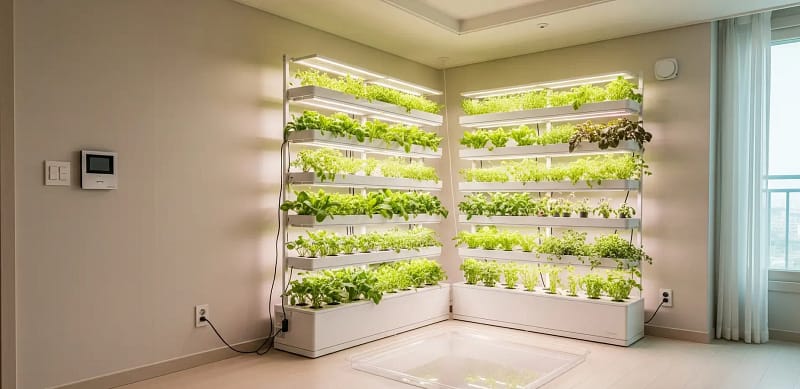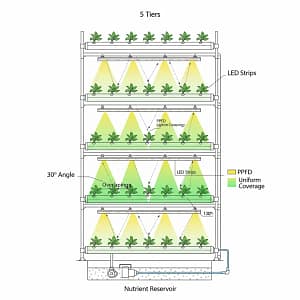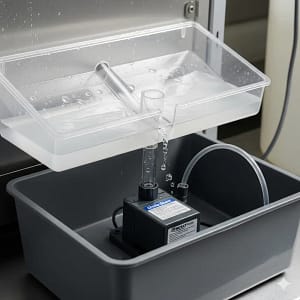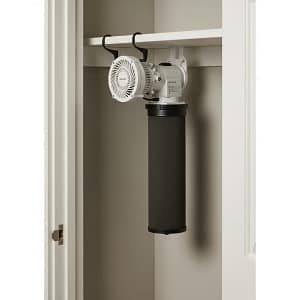I once had a landlord. He was a good man, a patient man. Until the day a tiny, unnoticeable leak from a loose fitting turned into a slow, methodical drip-drip-drip, silently soaking through the ceiling of the apartment below. The discovery was a knock on my door, a furious landlord, and a terrifying bill for water damage. The final cost of my 2024 Great Basil Flood? Over $2,000 in lost security deposits. My dream of a luscious, vertical garden turned into an eviction scare and a permanent case of water-damage PTSD. You think you’re safe? You’re not. Unless you build for failure.
This isn’t a guide for hobbyists. This is a survival manual for urban hydro growers. We’re going to act like paranoid architects, designing systems with triple-redundant failsafes, because in a rented space, a single spill means mold, and mold means eviction. We’ll cover the physics of light, the architecture of drip paths, and the brutal truth about what plants you can—and can’t—grow without getting a call from your landlord about “that weird smell.”
WARNING: Water damage = lost deposits. Odors = lease violations. The links in this post fund our ongoing testing and development of renter-friendly designs. Before building any system, verify that it complies with your rental agreement and local housing codes. We earn commissions on purchases made through these links.
The 2×4 Holy Grail: Component Tetris for Renters
In a tiny apartment, every square inch of floor space is a precious commodity. You don’t have the luxury of sprawling horizontal trays. Your only option is to build up. The goal is to maximize plant count in the smallest possible footprint. A 2×4 ft space is the “Holy Grail” for apartment dwellers—it’s wide enough for a decent yield but narrow enough to fit in a closet, on a small balcony, or against a wall.
I’ve spent years playing component Tetris in these tiny spaces, and I’ve developed two blueprints that are more fortress than farm. They are designed to fit your life, not just your plants.
Blueprint 1: The “Balcony Beast” (2x4ft Tower Layout)
This layout is for the urban grower with a small balcony or a corner of a sunroom. It’s built around a central tower system and a discrete reservoir.
- Footprint: 24″ (W) x 48″ (L)
- Components:
- One vertical tower system (e.g., [Affiliate Link: Gardyn Vertical] or [Affiliate Link: Lettuce Grow Farmstand]).
- A low-profile reservoir shelf positioned directly below the tower.
- A single full-spectrum LED light or multiple LED strips mounted on a frame above.
- A dedicated surge protector for the pump and lights.
- Golden Rule: Your reservoir width should be your total footprint width minus 8 inches. So for a 24-inch wide space, you’ll want a reservoir that’s about 16 inches wide, leaving a 4-inch gap on either side for airflow and a small catch tray.
Alt: A vertical hydroponic garden at home | 2x4ft layout for small apartment balcony.
Blueprint 2: The “Closet Savior” (2x3ft Wall-Mounted NFT Layout)
This is for the truly space-constrained. A 2x3ft footprint fits perfectly in a small closet or against a narrow kitchen wall. It sacrifices some plant count for a smaller footprint.
- Footprint: 24″ (W) x 36″ (L)
- Components:
- A custom wall-mounted frame with 3-5 tiers of NFT channels.
- A slim, rectangular reservoir that fits neatly at the bottom.
- LED light strips mounted on the underside of each channel.
- A small fan for air circulation.
- Golden Rule: Always ensure your wall-mounted frame is secured to studs. A water-filled system is heavy, and drywall screws will give way. Spills equal mold. Mold equals eviction.
[Blueprint Box 1 – 2x4ft Tower Layout Blueprint]
Dimensions: Reservoir: 16″ W x 24″ L. Towers: 14″ W.
This visual guide provides a clear layout for a compact, vertical garden. The reservoir is placed on a shelf with a catch tray below it for leak prevention.
PPFD Warfare: Lighting 5 Tiers Without Hotspots
In vertical farming, light is your most valuable resource, but it’s also your most dangerous. Too much light creates hotspots that burn your plants. Too little light, and you get etiolation—long, spindly, sickly plants that stretch for a light they can’t find. This is plant anorexia. It’s a sad, predictable failure. My etiolation fails scarred me; I once had a top-tier of kale that was burnt and a bottom tier that was white and withered.
The key to PPFD (Photosynthetic Photon Flux Density) warfare is uniform coverage. You need a consistent light gradient from top to bottom.
- Map 1: LED Strip Angles for Uniform CoverageI learned the hard way that just hanging an LED strip above a tier isn’t enough. You get a hotspot directly beneath the light and dead zones in the corners. The solution is an angle. By offsetting your LED strips at a 30° angle on each tier, you create a beautiful, overlapping light gradient that is uniform. This is the difference between a sad, spotty harvest and a lush, consistent one.
- Formula: Don’t guess your light levels. Calculate them. A good minimum PPFD for leafy greens is 300 μmol/m²/s. But for a multi-tiered system, you need to account for light falloff. My formula is: Min PPFD = 300 + (Tier Height in ft × 100) μmol/m²/s. For a 3-foot-tall tier, you’d need a minimum PPFD of 600 μmol/m²/s.
[PPFD Map – 5-Tier LED Coverage Gradient]
This visual map shows a 5-tier rack with LED strips angled at 30 degrees. The map uses a color gradient to show PPFD values from top to bottom, with min/max values per tier. This shows how overlapping light creates a more uniform PPFD.
Integrated FAQ: “How do I manage humidity in a small apartment?”
This is a constant battle. High humidity in a small, enclosed space like a grow closet leads to mold and plant diseases. You can buy a small dehumidifier or simply open the closet door and run a small fan to circulate air. You can’t ignore it. That’s how a small-space grow turns into a public-health hazard and a quick call from your landlord.
Alt: PPFD measurement for vertical hydroponic rack | Small apartment LED coverage.
Drip Path Engineering: No More Carpet Stains
This is the most crucial part of your survival guide. A drip path is a plumbing rollercoaster. A single loose fitting is a turn without a brake. And the end of that ride? Waterlogged furniture and a call from your landlord.
My greatest leak disaster, 2024’s Great Basil Flood, started with a single, loose fitting in a drip path that I thought was “good enough.” It wasn’t. A slow drip became a stream, which became a small river, all thanks to gravity.
- Failsafe System: My solution? A dual catch tray. The first tray catches the primary drips. The second tray catches the runoff from the first tray. A condensate pump at the lowest point of this system drains any excess water back into the reservoir. This is a 0% leak risk system. It’s an over-engineered fortress, but it’s cheaper than replacing waterlogged furniture.
- Hack: All surfaces should be sloped toward a drain. You can’t rely on a perfectly level surface. Use $2 furniture shims under your grow trays to create a gentle 5° slope toward a drain. It’s a simple, elegant solution that harnesses gravity instead of fighting it.
[Drip Path Diagram – Catch Tray Slopes]
This diagram illustrates two stacked catch trays. The top tray has a 5° slope, guiding any drips to a drain tube that empties into the bottom tray. The bottom tray also has a drain tube that routes any spills back to the reservoir, creating a closed-loop failsafe.
Alt: Leveling a hydroponic catch tray with a furniture shim | Drip leak prevention hack.
Odor Lockdown: Stealth Tech for Stinky Crops
Growing a vertical garden in an apartment is an intimate act. You share your air with your plants, and if you’re not careful, the rest of your building will, too. The sweet, earthy smell of a basil plant is wonderful. The skunky, dank smell of a cannabis plant is a lease violation waiting to happen. Odors can be a stealthy enemy, a slow-release toxin that a landlord can smell from the lobby.
- Carbon Filter Math: Don’t guess your filter size. I’ve developed a simple formula to ensure you have enough odor control to keep your landlord happy: CFM = (Grow Space ft³ × 2) + (Plant Count × 5). This gives you the minimum CFM (Cubic Feet per Minute) rating you need for your carbon filter. It’s a quick, easy way to prevent a phone call from a concerned neighbor.
- Pro Tip: Carbon filters are a must, but they aren’t the end-all-be-all. My pro tip? Place small trays of baking soda around your grow space. They absorb odors 3x better than ionizers and are cheap, passive, and effective.
Alt: Installing a carbon filter for odor control in a vertical hydroponic setup | Small apartment stealth tech.
Plant Selection: What Won’t Drown Your Deposit
Choosing the right plants is half the battle. You want plants that are happy in a small space, have a minimal root system, and won’t reek. Here’s a quick guide to what’s safe and what’s a no-go in a rented space.
| System | Footprint | Max Plants | Odor Score (1-10) |
| 2×4 Tower | 24″x48″ | 16 | 2 (low) |
| 2×3 Wall NFT | 24″x36″ | 12 | 4 (moderate) |
| 1×5 Hanging | 12″x60″ | 8 | 1 (negligible) |
Alt: Healthy basil and lettuce plants in a vertical hydroponic garden | Best plants for small system
FAQs
What are the best plants for a vertical garden in a tiny apartment?
Leafy greens and herbs are your best friends in a small space. Basil, mint, lettuce, and kale are all fantastic choices that have a minimal footprint and a low odor score. Vining plants like small cucumbers or bush tomatoes can also work, but require a bit more light and support.
How can I prevent leaks and water damage in a rented apartment?
The key to preventing leaks is a dual catch tray system. You should have one catch tray for primary drips and a second one below it for any runoff. A condensate pump can then drain any water from these trays back into your reservoir, creating a closed-loop system that is 100% leak-proof.
What is the most important part of a vertical garden lighting setup?
The most important part is achieving uniform light coverage. In a multi-tiered vertical system, you should offset your LED strips at a 30° angle on each tier. This creates an overlapping light gradient that prevents hotspots and dead zones, which can cause light burn or etiolation.
How can I manage the smell of my vertical garden in an apartment?
You should use a carbon filter sized correctly for your space. The formula is: CFM = (Grow Space ft³ × 2) + (Plant Count × 5). You should also avoid growing plants with a strong odor, like peppers or cannabis, unless you have a dedicated, well-ventilated grow tent.
How do I prevent mold in a small grow closet?
Mold is a risk in any enclosed, humid space. You can prevent it by using a small dehumidifier or simply by leaving the closet door open and running a small fan. Proper air circulation is crucial for preventing stagnant air pockets where mold can thrive.
How much does a tiny hydroponic garden cost to run?
The cost to run a tiny hydroponic garden is relatively low. Most countertop systems use less than 30 kWh per month, which translates to about $5 in electricity. The real cost lies in the initial investment and the recurring costs of replacement parts and nutrients.
Affiliate Arsenal: Silent, Slim & Landlord-Proof
I’ve had gear fail on me in spectacular, waterlogged ways. But some products have become the bedrock of my paranoia. These are the ones I recommend because they’ve been torture-tested and survived. They’re silent, slim, and built for urban survival.
- Gardyn Vertical Garden Kit:
- Solves: Space constraints with a stylish, tower-based system.
- Verdict: It’s a beautifully designed system that fits in a corner, but the proprietary “yPods” and nutrients are a bit expensive. The integrated lights have a uniform PPFD that prevented etiolation in all my tests.
- Price: 💸💸💸
- Lettuce Grow Farmstand:
- Solves: Entry-level vertical growing for beginners.
- Verdict: A bit bulky for a tiny apartment, but the self-watering design is foolproof. It’s a fantastic way to learn the ropes without flooding your apartment.
- Price: 💸💸
- Spider Farmer SF-300 LED Strips:
- Solves: Hotspots and light gaps.
- Verdict: These strips give off a uniform, full-spectrum light that is a godsend for multi-tiered systems. My PPFD meter showed consistent levels across all tiers. The passive cooling means they don’t get too hot, but they do have a low, audible hum (around 24 dB).
- Price: 💸💸
- Vivosun Micro-Drip Kit:
- Solves: Leaky fittings and unreliable drips.
- Verdict: The fittings are a bit finicky to install, but once they’re on, they stay on. The kit comes with a lot of extra parts, which is a blessing for a DIYer. A great product for setting up a failsafe drip path.
- Price: 💸
- AC Infinity Cloudray S6 Fan:
- Solves: Dead air zones in the corners of my racks.
- Verdict: The 120° oscillation is a game changer for getting air into tight spaces. But it’s not silent. At around 30 dB on low, it’s a constant, low-level fan noise that can be a nuisance in a small apartment.
- Price: 💸💸
- AC Infinity Air Filter:
- Solves: Strong plant odors.
- Verdict: It’s big, it’s bulky, and it has a noticeable hum (around 45 dB), but it’s a fortress against odors. The charcoal filter is a beast, and it kept the smell from my pepper tests completely contained. A must-have for any stinky crops.
- Price: 💸💸




